10 Tips for Making Meanings
There are lots of ways to read a tarot card. The other day, I was rereading What’s in the Cards for You? by one of my favorite people on the planet, Mark McElroy. The book provides exercises (each one is about 15 minutes) that you do each day. One exercise, 15 minutes a day, 30 days. At the end, you assess your experience and find out what your best aptitude and inclinations are for using the tarot: educational, magickal, psychological, creative, predictive, or planning. It’s a clever book. I think a group that meets once a month could have fun with this, with each member doing the exercises and then coming together to do the assessment.
But I thought one of the exercises would be useful in another way. I like this method for working with a new deck, especially one that is not a RWS clone. It helps me get intimate with cards very quickly and also helps me leave my RWS lens at the door, so I can see the new deck on its own terms.
- What elements do you notice in the card illustration?
- Which element stands out to you the most?
- What numbers are associated with the card?
- What text, titles, or keywords appear on your card?
- What emotions do postures or expressions suggest?
- What meanings have others assigned to this card?
- What are the characters on this card doing? What were they doing just before this? What will happen next?
- If the characters on this card could talk, what advice would they offer you?
- If this illustration appeared on the outside of a greeting card, what would the message on the inside be?
- Based on what you discovered above, what are the best possible, worst possible, and a middle-of-the-road meanings for this card?











Yes, I agree! This book is great – I love it.
And it´s exactly this list that became my most favoured tool to get connected with every deck – even the well-known ones.
Personally,
I very much go with the art of a deck, the illustation, the expressions, how do the cards relate to one an other in a spread. Face to Face, Back to Back et all.
.
On the other hand,
I find it about impossible to read decks with Key Words, they really short out my Right Brain; or more they get my left brain going; Out of My way there Theres WORDS here for me to … you get the Idea.
.
Honestly, and I know they wont, but I would prefer if Llewellyn gave reader a choice between a clean deck and one with keywords, when Keywords are used.
Blessings, BB.
BTW, what happened to the 10 ways to pick a tarot card posting, it seems to be just gone?
[…] This post was mentioned on Twitter by Dax Carlisle and Llewellyn, barbaramoore. barbaramoore said: What does that #tarot card mean? http://www.llewellyn.com/blog/2010/09/10-tips-for-making-meanings-2/ […]
[…] 10 Tips for Making Meanings […]
I nabbed this book after reading your post and a few other things online. I love the author’s casual approach to tarot, and his sense of humor. This first exercise really got me thinking. I’m looking forward to the rest of the month and the practical insights to my daily life!